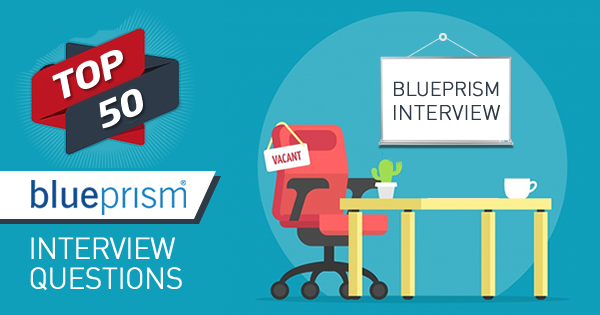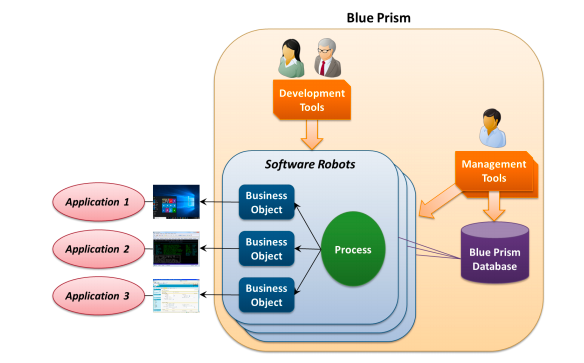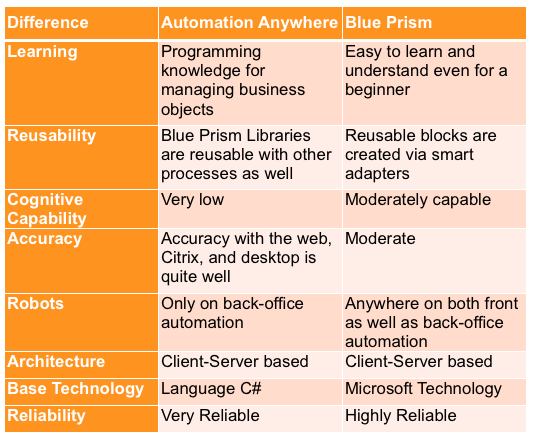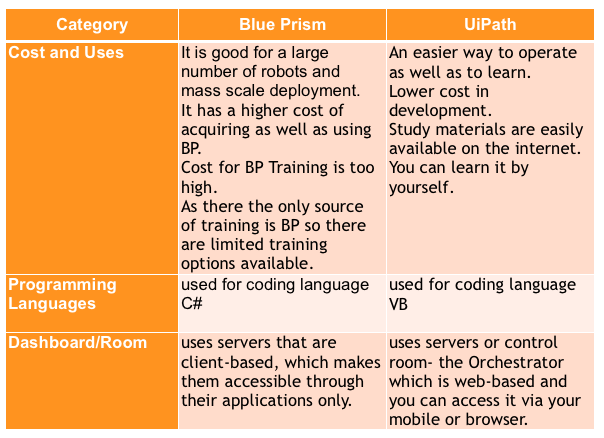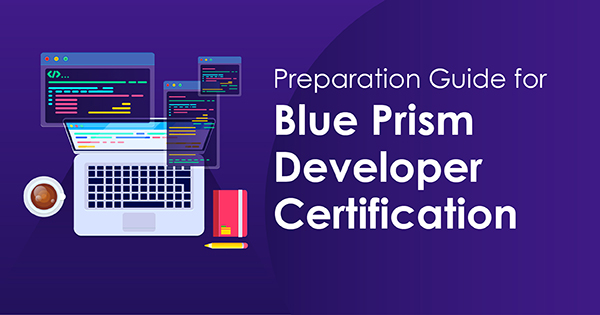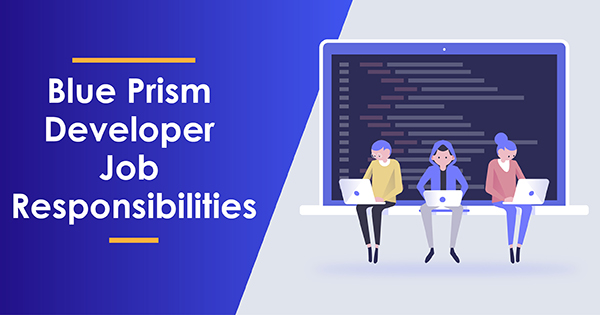Blue Prism is an RPA (Robotics Process Automation) tool that enables the implementation of robotics automation. It has been designed to automate business processes and optimize your work by automating, simplifying, and integrating the technology and processes.
It has become extremely important for any organization to use automation in their industry so that employees can focus on higher-value work and leave the transactions to the software robots which will perform their job tirelessly with the maximum efficiency. If you are thinking to build a career in RPA (Robotic Process Automation) then Blue prism is the ultimate tool to start with.
Try Now:
If you are going for blue prism interview whether as a fresher or experienced candidate, this set of top 50 Blue Prism interview questions and answers will help you to crack the interview. Let’s move ahead to read out top blue prism interview questions which are definitely going to be asked by the interviewer.
Top RPA Interview Questions
As RPA is the base of Blue Prism so in this section we’ve covered some important questions on RPA which could be asked by the interviewer. So, here we start with some RPA interview questions followed by the latest blue prism interview questions.
1. What is RPA? Explain the importance of RPA.
Answer: RPA stands for Robotic Process Automation and it is an automation technology for the business process. It functions on the concept of AI (Artificial Intelligence) or robot software.
RPA uses machine learning language for handling repeatable and high-volume tasks usually performed by the human race in past such as calculations, maintaining records or transactions, and queries.
2. Does Blue Prism come under RPA Tool? Do you know about any other RPA tool?
Answer: Yes, Blue Prism come under RPA tool. Some other RPA tools are UiPath, WorkFusion, OpenConnect, NICE, Automation Anywhere, Contextor, KOFAX, G1ANT, and KRYON.
This is one of the most common blue prism interview questions that you may come across. Interviewer may ask this question to check if you have some knowledge about the other RPA tools.
3. What are Business Objects and what’s their use in RPA application?
Answer: A real process is needed to do some useful tasks and, in any organization, to do so, there is a need to implement RPA system. It is needed to work on external applications.
The application interface is not contained in the diagram process but in the separate diagram and this diagram is called Business Object.
- A business object is configured in Object Studio environment, not in Process Studio environment.
- The main purpose of this Business object is to offer a single application, an interface.
- A Business Object is used by process always but not exposed to its own or control room.
4. What are thick clients and thin clients?
Answer: Thick clients are those applications which provide a large number of attribute properties while using the RPA tools. The examples of such applications are internet explorer, calculator etc.
Thin clients are those applications which do not provide any attribute properties while using RPA tools. The examples of such applications are any virtual environment and Citrix.
5. Is Robotic Automation Platform of Blue Prism auditable and secured?
Answer: In the Blue Prism robotic automation platform, Auditability and Security are inbuilt at many levels. The runtime environment is quite different from the editing process environment.
- To every authorized individual, permissions to create, run, edit, and design the process, as well as business objects, are specific.
- For any process, a full audit trail changes are saved. Before and after the effect of changes, the comparison is provided.
- For each process, at runtime, the log is created. And it provides every action’s time-stamped and detailed history as well as the decision made in an automated process.
6. How many days will it take to become self-sufficient in developing Robotic Automated Process?
Answer: The basic knowledge is covered in three days for creating a robotic automated process. For the creation of initial Operational Agility framework, candidates are expected to get full accreditation under the timeframe of the project. And in this timeframe, candidates can deliver the automated processes in this production environment and they will act as the instruments for generating the business benefits.
7. What would be the maximum cost of robotic process automation?
Answer: A full-fledged robotic automation office is around 1/3rd of the cost of the sourced agents globally. The ease of deployment and the flexibility shows the comparison as very easy to maintain which is useful to judge nest approach for given tasks.
8. Does Robotic Automation resemble macros or screen scraping? If no, then differentiate between them.
Answer: Clerical Robotic Automation is not like old technology such as macros and screen scrapping but generated from them.
Any application which is used by humans is also used by the robot of modern period whether it is legacy, bespoke application, mainframe, a 3rd party API hosted, or web server enabled service.
Robot accumulates imperative knowledge. This knowledge is stored into shared library over the time and used by another device or robot again.
Also Read: Introduction to RPA and Blue Prism
Basic Blue Prism Interview Questions for Freshers
If you are going for the blue prism job as a fresher then these blue prism interview questions will definitely help you during the interview. Just do a brush up of these Blue Prism interview questions and you will feel confident in facing the interview.
9. How many components are there in Blue Prism?
Answer: This is one of the frequently asked blue prism interview questions that can be answered in a direct manner. Blue Prism provides a set of tools, libraries, and runtime environments to RPA. There are basically two components or main parts of Blue Prism. These are –
- Process Studio
- Object Studio
10. Can you explain Blue Prism Lifecycle?
Answer: The blue prism life cycle is mainly divided into 3 phases.
Phase 1: The developer and tester are working with each other so that they can prove that the solution verifies the PDD.
Phase 2: Here you will get a repetition of Phase 1 but in process studio, tests are executed in live data testing more often.
Phase 3: This phase has certain steps:
- For the final test of acceptance, the process solution is installed with a test environment.
- Most importantly in the test, the solution could manage the increase of performance, environmental, and any remaining defects issues.
- The process runs in the control room of Blue Prism.
- Acceptance criteria must publish the sign off after meeting a full test report. Once it is done, now process can be executed in the production.
11. What is the importance of Blue Prism?
Answer: Robotic Process Automation with Blue Prism can be designed in IT Governance. It supports both external as well as internal decryption or encryption keys.
Audit Logs enabling is also provided by the blue prism. In the process of automation customized code .NET is used to a high level of robustness is needed.
You should know the importance of the platform you are using. So, this is one of the most common blue prism interview questions that you may come across in any role.
12. Demonstrate the basic differences between Automation Anywhere and Blue Prism.
Answer: Blue Prism and Automation Anywhere both are the RPA tools but different from each other. Let’s read the difference between two i.e. Blue Prism vs Automation Anywhere
You may generally come across this type of difference-based blue prism interview questions in the interview. The interviewer may ask such questions to check if you know how the tool you are using is better than others.
13. How Blue Prism Professional services can be supportive?
Answer: We can get a wide range of services with Blue Prism from mentoring and supporting with quick delivery via cutting-edge automation. We assure delivering benefits of business at agreed levels. In other words, it completely depends on the skills what you already possess in your home and want a robotic platform to make to work for them.
14. What Robotic Automation system can Blue Prism incorporate?
Answer: Blue Prism has integrated various technologies into its software based on previous years of experiences. These technologies are reliable, robust as well as secure. Blue Prism has developed technology adaptors for all the technologies which are employed with the presentation layer, Green Screen/ Mainframe, Citrix, Java, Web, Windows as well.
Just with a click of a button, we will be able to link with any kind of system after getting coupled with dedicated tools of a wide range. This application orchestration capability is proven, and it ensures that any new process can be designed, tested, and built rapidly without any significant effect on the current systems.
15. In what ways Blue Prism is different from UiPath?
Answer: Blue Prism and UiPath have their own tools of Studio and software which are very good. BP and UI both have visual process designers which are used to develop the solutions.
16. Is there any coding in blue prism?
Answer: This is one of the best blue prism interview questions that can be answered as follows. No, blue prism does not require any coding and it can automate any software. It is because blue prism has developed its digital workforce in such a way that it can be owned, built, and managed by customers or users, along with that, it is adhering to robotic operating model, spanning technology, and operations.
So, the digital workforce is implemented in any department where administrative work, as well as clerical task, is performed in any organization.
17. What do you understand by write stage?
Answer: Write stage is used to keep the values in the elements. And properties form is attached to the Data Items list on the left and with the list of elements on the right. We decide the middle section for the elements which we want to go with.
18. What do you think the uses of Recover stage are?
Answer: Recover stage either catches or attracts exception and give you or the designer an opportunity of creating some kind of recovery series. Once the exception is received, business object or the business process is in the Recovery Mode which means the exception is active or live. When passes through the Resume stage, it enables the diagram to continue a normal flow along with the coming out of the Recovery Mode. As the Resume stage is not to fix anything and it is a designer responsibility. The Exception Detail value does not need any quote but an expression.
19. What is the infrastructure of hardware needed to run the Robotic Automation Platform of Blue Prism?
Answer: Blue Prism is designed to match with robust IT standards suitable for IT operational supportability, security, and IT operational integrity. Either as a back-office process or as a front office process, this software is ready to be deployed. In front office processing, it runs smoothly on the standard desktop and in back office processing, it runs on any scale of systems.
20. What is Web service in Blue Prism?
Answer: Web service is an application component or client-server application for communication, a Software system used in an interoperable mission to mission communication, a communication method between two devices over a network, and a collection of protocols or standards for exchanging information between two applications or devices.
This is one of the most common blue prism interview questions asked in a blue prism developer interview. So, don’t miss and prepare yourself with the answer to this question.
Example: Java, .NET, PHP such types of languages interacts with RPA like Blue Prism, Ui Path, Automation Anywhere through web services.
Preparing for Blue Prism Developer interview? Check your current level of preparation with Blue Prism Developer practice tests.
21. How to start delivering process through Blue Prism?
Answer: Blue Prism endorses a kind of phased approach which starts as Operational Agility Framework and it is remarkably scalable. Initially, it is needed to target configuration of between 1 to 10 processes.
This is one of the best interview questions asked by the interviewer in a blue prism interview. So, get ready with the answer to crack the interview.
22. What is Priority Input Parameter in Blue Prism?
Answer: In Blue Prism, Priority Input Parameter should be set with the Add To Queue Action. Firstly, the items start functioning in order to the lowest priority number. The item which is set with 1st priority will be functioned before the items which are set on the priority 2.
Suppose, the Priority input parameter is still not set, by the default value of 0 which is the highest priority it will be used. The item which is going to function next tends to return in order of priority, and now the date will be loaded to the queue where the oldest will come first.
23. What is the Process Studio in Blue Prism?
Answer: A diagram created in Blue Prism Process is quite similar to the common business flow diagram. It resembles a traditional flowchart. In the Blue Prism area where processes are created is called Process Studio. And it looks like other process modeling applications as MS Visio. Also, it uses standard flow diagram notion and symbols.
24. What is the Object Studio in Blue Prism and how is it different from Process Studio?
Answer: An Object studio is where Visual Business Object can be created. It is also called VBO which is developed to interact with many other applications. Sometimes we find it similar to Process Studio but there are some differences between them.
- Object Studio provides some stages which we can’t find in the Process Studio.
- Object Studio has two default pages but doesn’t have the Main page.
- In object Studio, pages are not organized as hierarchy such as in Process Studio whereas it is organized as a flat group.
25. Explain Application Modeller.
Answer: This is one of the top blue prism interview questions asked in a blue prism developer interview. As a developer, you can answer this question as follows. You can adhere to the local naming convention with Application Modeller. This is typically shown as {element type} – {element name}.
Example: You need to create sections for the screen with each part. It makes the support easier and it mitigates the risks of being re-spied to the incorrect elements.
Thinking to take the blue prism developer certification exam? Go through this Blue Prism Developer Certification Preparation Guide and start your preparation.
26. What does SDD stand for and what is the purpose of the SDD?
Answer: SDD stands for Solution Design Document and its purpose is to describe the Blue Prism automation process which is derived in PDD.
27. What do you understand by Functional Requirements Questionnaire (FRQ)?
Answer: Functional Requirements Questionnaire (FRQ) are used to provide areas for consideration and a quick checklist for the required details.
28. What is Queue Manager in Blue Prism?
Answer: it is used to manage the items in a queue.
29. What do you understand with Environment Variables?
Answer: For all the Business Objects and Process, Environment Variables are available. Data Items are read-only and exposed as Environment Variable. One thing should keep in mind that type of Data Item and the name should match the Environment Variable.
30. What are the types of security in Blue Prism?
Answer: There are three kinds of security in the Blue Prism.
- User: We can assign new user information
- Credentials: store the secret information
- Options: there are rules for setting passwords
Often it happens that the freshers get stuck in even simple questions in the interview. To cope up with this weakness, we came up with this set of latest blue prism interview questions with detailed answers for the aspiring candidates. Going through the above blue prism interview questions will help you crack the your blue prism interview.
Advanced Blue Prism Interview Questions for Experienced
This section is dedicated to the advanced blue prism interview questions for experienced candidates which will prove to be a great help in the interview. Let’s have a look at these top blue prism interview questions.
31. What do you think of Mark Exception and System Unavailable Exception in Blue Prism?
Answer: As a developer, you may probably come across this blue prism interview question. You can answer this question in a direct manner. There are two flag inputs in Mark Exception action and these are ‘Keep Locked’ and ‘Retry’ use for controlling the features. When a new item is developed, it will return its ID into the output parameter of this New Item. Once keep Locked is set to True, a new item will be under the control of the process.
If you are not able to launch the application, sub-page or action will throw a System Unable Exception. This exception is not related to the Work Queue item issue which might be working presently. You need to unlock the item simply not just marking it as an exception.
32. What are the benefits of Developing Visual Business Object (VBO)?
Answer: There are many benefits of developing Visual Business Object (VBO), some of them are given below.
- Scalability as well as consistency.
- For the subsequent process, there is less time for Bot creation.
- System changes are only needed to be updated in one location, not in each process. It makes Bot maintain smooth and easy.
33. Mention the steps to create a Web service in Blue Prism.
Answer: Here are the steps to create a simple calculator process in Blue Prism – a virtual workforce.
Step 1: First, log on to the Blue Prism- virtual workforce.
Step 2: Now go to the Studio ?Object.
Step 3: Now create a web service (WS) group.
Step 4: Here you have to create a simple object, we are doing CalcWS.
Step 5: Now enter the descriptions as Calc Function over web services.
Step 6: Now click on the finish button. And now you have created the object CalcWS.
Step 7: Now double click on this and you will enter inside the page object studio-edit-CalcWs. Click on Action1 button now name it as Add_WS just by clicking the right mouse button in that Action1 button.
Step 8: Now double clicking will navigate you to the page information where you have to provide the description such as Add two number and return results. Now click ok.
Step 9: You are now on your Blue Prism. As we are going to do addition, we need to select the calculation option. Now double click on the Calc1, you will be navigated to the calculation properties. Here you have to provide the name as: Add two numbers.
Step 10: In the expression field, we have created two numbers just by clicking on numbers options, here we create input numbers Data1 and Data2, and output Data3.
Step11: Drag both of them to the expression but drag output Data3 in the result. Click on the validate button.
Step12: Now click on the evaluate expression where you have to enter the value of Data1 and Data2 and these will be stored in temporary values, you will find the result value after clicking on Test button.
Step13: Now link the start button where input numbers are given, to add two numbers box add it to end where output number is Data3 in the blue prism. Now test this diagram by clicking the go button. Now save the Business object just by clicking the save button.
Step 14: You can check the process by clicking the go button if the inputs are given.
34. What does OID stand for? Define it.
Answer: OID stands for Operational Impact Document. OID is used to inform the client operation team what it is responsible for change after automation solution has occurred. OID is a description for change which has impacted on them after implementation of solution successfully.
To check the execution of the automated solution and its impact on the business, done by SDD and OID. There is a workshop which played out, it is PDD.
35. What do you know about PDI?
Answer: If you are at a blue prism architect role, you may come across this type of blue prism interview questions. So, just read the answer and get prepared for the interview.
PDI stands for a Process Design Instruction. PDI is a blueprint so that it develops a process where information with low level can be included in PDI after excluding it from SDD that makes the process clear.
Preparing for Blue Prism Professional Developer certification exam? Check your current level of preparation with Blue Prism Professional Developer Practice Tests.
36. How does the process run in the Control Room?
Answer: There are two methods to stop the process:
1st is by clicking Stop Section, and
2nd is by selecting process session.
These two processes will help you in the Control Room to stop the running Process with immediate effect. In blue prism, if the current process is not completed, it will be marked with Exception at Clean Up.
There are two stop options which you can see while making right click on the running process session.
- Request Stop
- Immediate Stop
Request Stop asks the process to stop at a configured safe stop in the process whereas Immediate Stop behaves just like Stop Section.
37. How can safe stop be configured?
Answer: Within the Decision stage, use of IsStopRequest(), an inbuilt Environment function, can help to configure safe stop in the process.
38. What do you know about Log Viewer?
Answer: To inspect log of the session, the Log Viewer is used in both scenario of either it is running or after it is finished. It is very convenient for tracking problems down and for reviewing work progress. The Log Viewer is equipped with a search function which enables you to see through the visibility of columns and rows of the log.
39. What is new Environment Variable “Stopping Time”, a value of “three or four minutes from now” and with data type “Time”?
Answer: A new Environment Variable which is named “Stopping Time”, a value of “three or four minutes from now” and with data type “Time”. To use the variable, create the latest Process which is named with “Stopping Time” now create a data item with name “Stopping Time”, and now use Exposure field which will link it with Environment Variable.
Now, let’s prepare with some very short answer type blue prism interview questions that are most commonly asked in a blue prism interview.
40. What type of exception is not generated in the exception stage?
Answer: Business Exception
41. How to exit from spy mode in Blue Prism?
Answer: Ctrl+ Right Click.
42. What are the Tags available in Blue Prism?
Answer: The keyword of terms which is assigned to Work Queue items.
43. In Blue Prism, how does the stop request know at what time to stop?
Answer: Always in 3 stages, it stops.
44. Explain Wait stage and what is “Always throw an exception” on timeout and “Always with for the screen to change”?
Answer: Wait stage: The wait in the starting of any action gives confirmation to the process on the correct path and it absorbs system latency which helps to increase the process resilience.
Always throw an exception on timeout: You should not try as well as retrieve the process though wait stage. You should try the exception and let the process handle it. It may choose to restart the system or try again after few times or an alert.
Always with for the screen to change: you should use wait stages after navigating to any stage that is the reason to update the screen. It will ensure to run fastest but not absorb any latency.
45. Why the exception takes place at the time of launching an application and what is attached to the application while launching?
Answer: If the business object is attached to the application but there is another attempt of attaching the application again, this will be a cause for an exception. At the time of launching an application, there will be a business object attached automatically.
For a blue prism developer, it is one of the frequently asked blue prism interview questions. The interviewer asks such questions to check the exception handling skills of the candidate.
Also Read: Role and Responsibilities of a Blue Prism Developer
46. What is the purpose of Business Object and how to check the object attached with the application or not?
Answer: Business Object is the main purpose of providing the interface to a single application. It is not exposed to the Control Room and it is used by the process as it never uses by itself.
To check whether the project is attached to the application or not, it is needed to use the top or root element in an application model and then select the option – read operation then it will be connected.
47. What do you understand by Attach?
Answer: Input value is needed to attach and Input value helps to identify the application. These input values are like Process Name or Window Title. It is a simple but one of the top blue prism interview questions asked in the interview so don’t miss it.
48. What do you think by “Preserve” checkbox and tell the suitable time to use it?
Answer: While using the Exception stage it is necessary to understand the “Preserve” checkbox and suitable time to use it. You can notice the Exception details and the Exception Type fields have got disabled while checking the checkbox.
Checkbox checking shows that recent exception will be either thrown again or re-released and any new information is not necessary. And because of that “Preserve” checkbox is only used for the Recovery Mode and it is somewhere between Resume stage and Recovery stage.
- If you use the checkbox outside of the Recovery mode, it will generate the exception. The diagram shows the appropriate use of the “Preserve” checkbox.
- If a new exception is put outside of the Recovery Mode, the checkbox has not checked, and the details of exception are provided.
- If in the Recovery Mode, the right-hand exception is put, it means that checkbox is checked.
- Exception makes it sure that it is thrown after Resume Stage so that before the new exception is created, the current exception is neutralized.
49. What do you understand with Session Variables?
Answer: As the name suggests Session variables are applicable to sessions like running processes. Session variables are exposed outside to the diagram just like Environment Variables.
To the occasion of the running process, Session Variables are very specific. At a particular time of the process, two instances of the process are running, they will have the same session variables with different values.
In the System Manager, there is no need of setup to Session Variables. In the Control Room, you can see as well as modify the Session variables. Data Items are writable and exposed as Session Variable.
50. Can you set the priority to work with Queue items in Blue Prism, How?
Answer: Yes, we can set the priority to work with Queue items in Blue Prism. The first item is added to the queue with the help of Add to Queue action. And to work with the Queue item, the priority setting process is started. Once the priority of an item is added to the queue, it can’t be changed.
So, in this section, we’ve covered some of the most advanced Blue Prism interview questions that will be very helpful if you are switching to your next job. These are the top blue prism interview questions that will prove a helpful resource to demonstrate your skills in the interview.
Final Words
The world of Robotics Process Automation is booming at a high pace. Blue Prism, being one of the most popular RPA tools is bringing a number of opportunities for the blue prism experts. So, these are the 50 best blue prism interview questions and answers, you must be prepared with before going for the blue prism interview.
However, we can’t neglect the value of certification. So, it is recommended to get certified with a blue prism certification and add a credential in your resume. It will demonstrate your skills to your interviewer in the interview and make you stand out of the crowd.
Whizlabs is pioneering the online certification training industry and the practice test series for Blue Prism Developer certification and Blue Prism Professional Developer certification have been created by the blue prism experts to help you pass the certification, and ultimately, the interview.
So, don’t think much validate your skills with a blue prism certification and prepare with these latest blue prism interview questions to boost your career.
Good luck with your interview!
- Top 20 Questions To Prepare For Certified Kubernetes Administrator Exam - August 16, 2024
- 10 AWS Services to Master for the AWS Developer Associate Exam - August 14, 2024
- Exam Tips for AWS Machine Learning Specialty Certification - August 7, 2024
- Best 15+ AWS Developer Associate hands-on labs in 2024 - July 24, 2024
- Containers vs Virtual Machines: Differences You Should Know - June 24, 2024
- Databricks Launched World’s Most Capable Large Language Model (LLM) - April 26, 2024
- What are the storage options available in Microsoft Azure? - March 14, 2024
- User’s Guide to Getting Started with Google Kubernetes Engine - March 1, 2024

